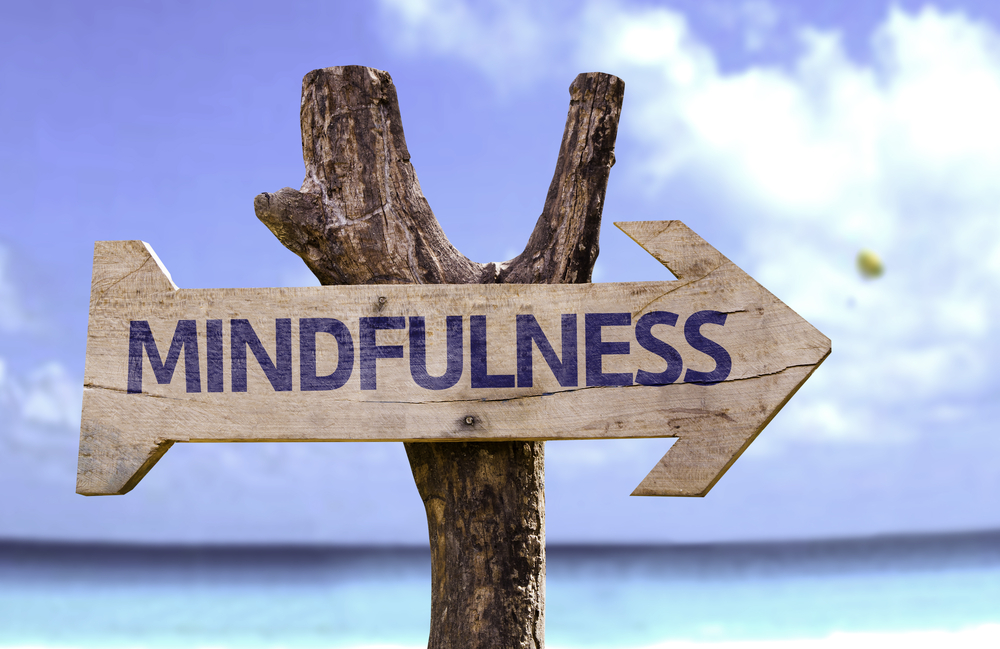BY CARRIE GAVIT
With eyes closed, feet firmly on the ground, back straight, begin to notice your breaths and the air moving in and out. Deeply inhaling and exhaling, notice how each part of your body feels.
These are the beginning steps to a mindfulness exercise scripted by Dr. Russ Harris, author of The Happiness Trap. As the exercise continues, participants focus on their thoughts and body in order to practice the act of mindfulness. According to psychologist Dr. Marsha M. Linehan, mindfulness is “awareness without judgment of what is, via direct and immediate experience.” Dr. Russ Harris expands on this by explaining that mindfulness helps to “reduce stress, increase self-awareness, enhance emotional intelligence, and effectively handle painful thoughts and feelings.”
As someone who always struggled to understand and participate in the mindful aspects of yoga classes, I wasn’t sure what to make of the mindfulness exercises on their own. At the end of a yoga session, I was ready to get up and move on to the next part of my day. Laying on the floor for ten minutes to gather my thoughts or to reflect did not sound appealing. Yoga was crossed off my to-do list as soon as the physical component ended, and I was ready to cross the next item off my daily to-do list.
Fortunately, I eventually learned to value mental, emotional and spiritual health to the same extent as physical health. I realized there had to be a purpose to those extra ten minutes at the end of yoga class and dedicated time, energy and focus to discovering the significance of mindfulness to my overall well-being. Part of the difficulty for me was I didn’t understand how simple the act of mindfulness could be in practice. It does not require you to pay $10 for a yoga class, to be alone in a quiet room without any disturbances or for you to rid your mind of all negative thoughts. Rather, the practice of mindfulness only requires you to be ready and willing to focus on the here and now. Mindfulness is a practice focused on being present. It could be focus directed toward the thoughts that enter your mind as you acknowledge them or it could be focus directed toward your body and your breathing in a private space similar to the mindfulness exercise previously described. It could be reading a book you enjoy in public without fear or embarrassment as to what others think about you or the moment you take in your office at work after an uncomfortable meeting to focus on your breathing in order to calm down, assess your thoughts and come back to the present moment.
The practice of mindfulness taught me to re-learn how to breathe. In the midst of anxiety, panic and nerves, I realized the importance of each breath. Because it’s something that comes so naturally, we don’t often pay attention to how we breathe. We don’t consider it a tool we are each equipped with that could transform each day into one of mindfulness. Each breath can bring calmness, peace and a recognition of what we are thinking and feeling in that moment. By acknowledging what we are thinking and feeling, we can process it, deal with it and move on with our days. In the grocery store, the classroom, the café or the park, surrounded by friends, family, strangers or by myself, taking a moment to practice mindfulness through each breath I take allows me to make the most of each present day. Just completing my daily to-do list does not instill a calm as pervasive as the few moments I dedicate to breathing deeply, eyes shut, feet firmly on the ground, with my back straight. It’s a small aspect of mindfulness I carry with me throughout my day.
ABOUT THE AUTHOR
Carrie Gavit is a recent grad of the University of Texas at Austin. She received her MA in Women’s and Gender Studies and studied the U.S. slaughterhouse industry. Follow her @CarrieGavit.
Mindfulness photo via Shutterstock.



